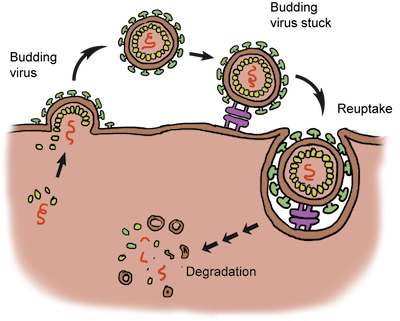Restriction Factors
Restriction factors are proteins that block virus infection by restricting its replication progress. These factors are part of the innate immune defense, and mostly block virus infection early in the replication cycle. Many of these factors have been found to target retroviruses, but also have activity on other viruses. These factors include:

Cytosine Deamination
APOBEC3 is one of a group of proteins in humans (it is only one protein in mice) that changes cytosine nucleotides in RNA into thymines, simply by removing an amino group. This changes the sequence of the RNA genome so that C's are changed to T's and G's are changed to U's when reverse transcriptase completes making the double-stranded DNA genome. This leads to mutations that will stop protein synthesis early, preventing new virus proteins from getting made. The activity of APOBECs is exclusive to retroviruses because they can only target double-stranded RNA/DNA hybrids in the cytoplasm.

Tetherin Activity
Unlike APOBEC3 and TRIM5α, which are mostly retrovirus-specific, tetherin is a restriction factor that broadly blocks virus spread. Tetherin, like its name implies, prevents enveloped viruses from budding out of a cell. Tetherin is a membrane protein that is incorporated in budding viruses and effectively "tethers" the virus to the plasma membrane, so it can't leave. These particles that can't escape are eventually taken back up and degraded by proteases.
- TRIM5α
- APOBEC3 family of proteins
- Tetherin

Cytosine Deamination
APOBEC3 is one of a group of proteins in humans (it is only one protein in mice) that changes cytosine nucleotides in RNA into thymines, simply by removing an amino group. This changes the sequence of the RNA genome so that C's are changed to T's and G's are changed to U's when reverse transcriptase completes making the double-stranded DNA genome. This leads to mutations that will stop protein synthesis early, preventing new virus proteins from getting made. The activity of APOBECs is exclusive to retroviruses because they can only target double-stranded RNA/DNA hybrids in the cytoplasm.

Tetherin Activity
Unlike APOBEC3 and TRIM5α, which are mostly retrovirus-specific, tetherin is a restriction factor that broadly blocks virus spread. Tetherin, like its name implies, prevents enveloped viruses from budding out of a cell. Tetherin is a membrane protein that is incorporated in budding viruses and effectively "tethers" the virus to the plasma membrane, so it can't leave. These particles that can't escape are eventually taken back up and degraded by proteases.